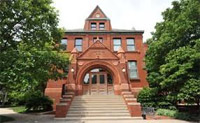Architecture, College of

Masters in Architecture Program: Theses
First Advisor
David Newton
Date of this Version
Spring 5-2023
Document Type
Thesis
Abstract
A micropolitan statistical area refers to a geographic region in the United States that has at least one urban cluster of population between 10,000 and 50,000 people, as defined by the US Census Bureau. According to the 2019 Fiscal Year Public Libraries Survey, more than three-fourths of public libraries serve areas with fewer than 25,000 people in the U.S. (Frehill, et al. 2021). However, as new design techniques and advanced services are developed, they tend to be primarily implemented in libraries serving metropolitan areas, which only serve around a quarter of the US population, leading to an unequal distribution of resources and potential disadvantages for residents of micropolitan statistical areas. This presents an issue of unequal distribution of resources, as micropolitan areas often lack the funding and resources to invest in high-quality library design and amenities, resulting in lower quality facilities compared to those in metropolitan areas. The lack of funding within micropolitan statistical areas can further contribute to the digital divide and hinder access to information for those living in these regions. In these micropolitan statistical areas, there is often a lack of libraries or a general access to books, creating book deserts which can result in lower literacy rates, poorer educational outcomes, and overall lower quality of life for residents. In order to address these issues and promote greater literacy and well-being, it is crucial to increase investment in public libraries in micropolitan areas, including expanding access to books and other valuable services.
This thesis proposes to address the challenges of constructing public libraries that are both high-quality and affordable. A design manual focused on adaptive reuse and circular design techniques will offer a solution to reduce the building cost of new public libraries, without compromising the quality of design. By integrating higher quality design into the process, this manual will help create a higher quality of life for library patrons and staff alike. The manual would include techniques for creating affordable high-quality design, and would be structured as a flexible system that can be tailored to a range of budgets and needs. Similar to a choose your own adventure book, users would build from existing conditions and techniques from the ground up, with thousands of possible combinations. Such a manual will help address the issue of inequitable distribution of resources by providing a tool for creating public libraries that are accessible to a wider range of communities, including those in micropolitan statistical areas.
This thesis proposes a new design process that integrates a variety of information in a new format, including a catalog of systems that creates a mode of creation for quick generation of building design. By relating existing data in a new format, this thesis provides a representational design process to solve a design problem. The proposed design manual focuses on adaptive reuse and circular design techniques to lower the building cost of new public libraries, while still integrating higher quality design to create a higher quality of life. Ultimately, this thesis provides an innovative approach to building design, which not only benefits the field of architecture but also positively impacts public libraries in the US by providing affordable and high-quality design solutions that can be customized to meet the unique needs of different communities.


Comments
A design thesis Presented to the Faculty of The College of Architecture at the University of Nebraska In Partial Fullfillment of the Requirements For the Degree of Master of Architecture, Major: Architecture, Under the Supervision of Professor David Newton. Lincoln, Nebraska: May 2023
Copyright © 2023 Samantha Zeek